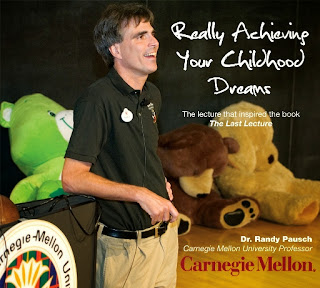Randy Pausch was a professor at Carnegie Mellon who developed pancreatic cancer and was only given a few more months to live. Randy Pausch says, "If you have one last lecture, what would you teach about?". Randy chose to teach about achieving your childhood dreams. His last lecture tells us a lot about what we can learn about teaching and learning. Taking advice from a World Book author and a creator of virtual realities wouldn't be such a bad idea.
Pausch's last lecture is very engaging while very amusing. He first brings up the importance of brick walls. Brick walls let us prove how badly we want things. How bad will you strive for success? What if something gets in your way? If something does get in your way of something you want. Randy says don't let it stop you from achieving your dreams; therefore, knock the brick wall down. Pausch continues his lecture with the importance of criticism. People in your life only criticize because they care. You have a problem if your teacher stop criticizing you. Its a sign they have given on the success you can achieve. A very influential quote Randy Pausch states is,"experience is what you get when you didn't get what you wanted". That is nothing but the truth because you may not get everything in life you always dreamed of, but you got the journey it took to try and reach those dreams. It's all about finding the positivity in the journey to your dreams.
Pausch introduces the act of a "head fake" in the classroom. A head fake is used to trick your student's into learning more than what they think they are. So your kids are learning algebra and after you have taught the lesson you assign practice homework. The practice homework is not due the same day as the lesson was taught, so it is up to your student's to complete the given work with a chosen group and have it turned in by a specific day and time. The fact that the assignment is outside of the classroom, and the students are divided into groups, it gives them a chance to learn much more than algebra. They have to learn organizational skills by creating time for their group to meet and complete the assignment. They learn teamwork by collaborating their knowledge and cooperation. Both organization and teamwork are inconspicuously taught while algebra is being taught. Head fakes are a great way for your students to learn indirectly!
Randy Pausch had such a positive outlook on life and teaching. I definitely plan on using his tactics in the classroom. Out of the lecture I took great joy in learning about head fakes. Only because I had never thought of it that way, which will come in handy when using project based learning in my classroom. All of his ideas I can put to good use in my classroom in the future and it is a great opportunity to learn from such a well known expert.












